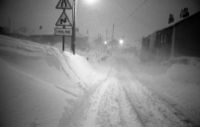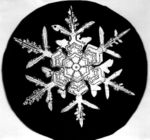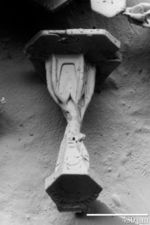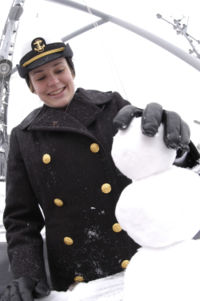Snow
2007 Schools Wikipedia Selection. Related subjects: Climate and the Weather
Snow is precipitation in the form of crystalline water ice, consisting of a multitude of snowflakes. Since it is composed of small rough particles it is a granular material. It has an open and therefore soft structure, unless packed by external pressure.
Snow is commonly formed when water vapor undergoes deposition high in the atmosphere at a temperature of less than 0°C, and then falls to the ground. It can also be produced by hoar frost which falls from the surface on which it is formed, or falling particles of ice fog formed when the humidity in surface air freezes at very low temperatures. Snow is less dense than rain, which means the same amount of moisture will produce a greater volume of snow than it will rain. One rule of thumb is that the water in eight units of snow is equivalent to one unit of rain. See Snow density.
Occurrence
The probability of snowfall varies with season, location, and other geographic factors such as latitude and elevation. In the latitudinal area closer to the equator, there is a rather small chance of snowfall, 35° N and 40°S are often quoted as a rough delimiter. The western coasts of the major continents remain devoid of snow to much higher latitudes.
Permanent snow covering is affected by factors such as the degree of slope on the land, amount of snowfall and the force and nature of the winds. As temperature decreases with altitude, high mountains, even near the Equator, have permanent snow cover on their upper portions, around 5,300 m high. Examples include Mount Kilimanjaro in Tanzania and the Tropical Andes in South America; however, the only snow actually to appear on the Equator is at 4,690 m altitude of the southern slope of Volcán Cayambe in Ecuador ( Google Earth images).
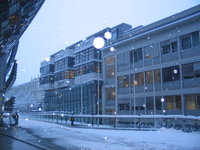
Conversely, many regions of the Arctic and Antarctic receive very little precipitation and therefore experience little snowfall despite the bitter cold (cold air, unlike warm air, cannot take away much water vapor from the sea). Here, the snow does not melt at sea level. In addition to the dry, snowless regions of the poles, there are some mountains and volcanoes in Bolivia, Chile and Argentina that are high (4,500 m-6,900 m) and cold, but the lack of precipitation near the hyperarid Atacama Desert prevents snow from accumulating into glaciers.
Benefits and problems

Snow is used as a thermal insulator conserving the heat of the Earth and protecting crops from the freezing weather. On the other hand, substantial snowfall sometimes may even disrupt the infrastructure and services of a region that is accustomed to such weather. Automotive traffic may be greatly inhibited or may be stifled entirely. Basic infrastructures such as electricity, telephone lines, and gas supply can also be shut down. This can lead to a " snow day", which is a day on which the school or other services are cancelled due to an unusually heavy snowfall.
In areas that normally have very little or no snow, a snow day may occur with light accumulation or even the threat of snowfall. A mudslide, flash flood, or avalanche can occur when excessive snow has accumulated on a mountain and there is a sudden change of temperature.
Snowflake
A snowflake is an aggregate of ice crystals that forms while falling in and below a cloud. They are typically hexagonally symmetrical.
Geometry
A snowflake always has six symmetric arms (along three symmetric axes), which arises from the hexagonal crystal structure of ordinary ice (known as ice Ih) along its 'basal' plane.
There are, broadly, two possible explanations for the symmetry of snowflakes. Firstly, there could be communication or information transfer between the arms, such that growth in each arm affects the growth in each other arm. Surface tension or phonons are among the ways that such communication could occur.
The other explanation, which appears to be the prevalent view, is that the arms of a snowflake grow independently in an environment that is believed to be rapidly varying in temperature, humidity and other atmospheric conditions. This environment is believed to be relatively spatially homogeneous on the scale of a single flake, leading to the arms growing to a high level of visual similarity by responding in identical ways to identical conditions, much in the same way that unrelated trees respond to environmental changes by growing near-identical sets of tree rings. The difference in the environment in scales larger than a snowflake leads to the observed lack of correlation between the shapes of different snowflakes.
However, the concept that no two snowflakes are alike is not necessarily true. Strictly speaking, it is extremely unlikely for any two objects in the universe to contain an identical molecular structure; but, there are, nonetheless, no known scientific laws which prevent it. In a more pragmatic sense, it's more likely, albeit not much more, that two snowflakes are visually identical if their environments were similar enough, either because they grew very near one another, or simply by chance. The American Meteorological Society has reported that matching snow crystals were discovered by Nancy Knight of the National Centre for Atmospheric Research. The crystals were not flakes in the usual sense but rather hollow hexagonal prisms.
Electron microscope gallery
Density
The water equivalent of a snow pack is the amount of water that it contains, regardless of its depth. For example, if the snow covering a given area has a water equivalent of 5 m, then it will melt into a pool of water 5 m deep covering the same area. This is a much more useful measurement to hydrologists than snow depth, as the density of even freshly fallen snow widely varies. New snow often has a density of around 12% of water, and even under cold conditions, the same snow will settle under its own weight until it is approximately 33% water. More snow on top of this will compress it even further. By late spring, snow densities often exceed 50% of water .
Water equivalent is of great interest to water managers wishing to predict spring runoff and the water supply of cities downstream. Measurements are made manually at marked locations known as snow courses, and remotely using special scales called snow pillows.
Superlatives
The highest seasonally cumulative precipitation of snow ever measured was on Mount Baker, Washington in the United States during the 1998– 1999 season. Mount Baker received 1140 in. (29 m) of snow , thus surpassing the previous record holder, Mount Rainier, Washington which during the 1971– 1972 season received 1122 in. (28.5 m) of snow .
Recreation
Some forms of recreation depend on snow
- Many winter sports, such as skiing, snowboarding, ice skating, snowmobiling and snowshoeing
- Playing with a sled or riding in a sleigh
- Building a snowman or snow fort
- Throwing snowballs mutually in a snowball fight or at others to tease them. (Humans seem to be the only being that throw their snowballs. Pygmy chimpanzees have been known to carry snowballs around, but never to throw them.)
- Making a snow angel
Where snow is scarce but the temperature is low enough, snow cannons may be used to produce an adequate amount for such sports. The world's biggest snowcastle is built in Kemi, Finland, every winter.

